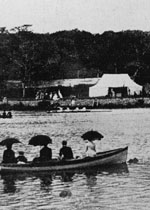Old Galway
Seapoint Ballroom (16 07 2015)

Sixty six years ago tomorrow, on July 17th, 1949, Seapoint Ballroom was officially opened by Joe Costelloe, Mayor of Galway at 10pm.
The sense of anticipation was palpable leading up to the event. “When visited a few days ago while the men were at work, the place reminded one of the interior of a huge bee hive. There were men in two’s and three’s in all parts of the building putting the finishing touches to a year’s hard work, and tidying and cleaning the place so that everything would be spick an span for the grand opening. Built on the most modern lines the building includes on the ground floor a huge restaurant of approximately 4,000 square feet. When fitted with 90 tables, this will provide accommodation for 350 diners. The kitchen will provide all the confectionery for the restaurant. There will be 4 small shops in the front of the building which will sell ice cream, sweets etc. The ballroom situated on the upper level has a floor area of 5,200 square feet which will accommodate over 2,000 dancers. Surrounding the floor is a balcony with seating for a few hundred people”.
The Galway Fishery (09 07 2015)

The first documented reference to the Galway Fishery is found in the Pipe Rolls, a collection of financial records maintained by the British Treasury. The Rolls of 1283 AD refer to the fishery at the time being part of the property of Walter De Burgo. The fishery passed through several ownerships until 1521 when Henry VIII granted a licence to Janet and Anthony Lynch to have 3 nets upon the river of Galway between the bridge and the sea and to build one water mill upon the river wherever they thought proper.
Peg Broderick-Nicholson & The War of Independence (02 07 2015)

Peg was born at 17, Prospect Hill of parents with a strong nationalist outlook. She went to school in ‘The Pres’, where after the 1916 Rising, there was a pitched battle between the wearers of the red, white and blue badges (common during World War 1) and those wearing green white and gold badges. The green side won but then, all the badges were confiscated by Mother Brendan.
There is Nothing as 'Galway' as Our Lady's Boys Club (25 06 2015)

As President Michael D. Higgins said recently on a visit to Sea Road, “Our Ladys Boys Club was built on a vision”. It was founded in 1940, the main object being “To provide for the relief of poverty by serving homeless kids in need, by promoting human services which would meet long-term needs and by these means to encourage their development and give their lives a dignity which is their birthright”. Fr. Leonard Shiel S.J. was the inspiration behind the project. He has given thousands of young Galwegians and the City of Galway a rich legacy.
Cattle Fair in Eyre Square (11 06 2015 repeated 18 06 2015)

Deltiology is the name given to the practice of collecting old postcards, from the Greek Deltos, “writing tablet, letter”.
Anyone who has studied the changing face of their locality through old images will realise that one of the great sources can be old postcards. Topographical views on postcards became very popular towards the end of the 19th century and that trend continues today. The publishers of these cards often reproduced unusual views as you can see if you read Paul Duffy’s two books Galway, History on a Postcard and Galway City, Snapshots through Time, both of which are highly recommended.
An Elegant Streetscape (04 06 2015)

There is a lovely vintage quality about this photograph of the most elegant corner in Galway which was taken about 1950 at almost 6.15 in the afternoon. It shows how the three corner buildings, all of which are slightly rounded, complement each other. It was always known as Moon’s Corner or Dillon’s corner, never McNamara’s corner.
John Hosty, 1916 Veteran (28 05 2015)

For John Hosty from Shantalla, the ‘physical force’ movement originated some time before 1910 with the publication of “The United Irishman”, a newspaper which kept a lot of young people from following ‘the constitutional movement’. When the 1913 Oireachtas was held in Galway, Seán McDermott used the occasion to swear in a number of young Galwegians to the I.R.B. and from then on they did all they could against the Irish Party, including distributing anti-enlisting literature at all hours of the night.
May Sunday at Menlo (21 05 2015)

Maytime was traditionally considered a time for festivals, and Galway was no exception to this. In fact it used to be said that the citizens had an almost reverential attachment to the old custom of going out to Menlo for three Sundays in May to partake in the pleasure of the open air and the early summer sun. It was known as ‘Maying in Menlo’.
.png)